Protatlanta souleyeti
Roger R. SeapyIntroduction
Protatlanta souleyeti is a small species (<2 mm shell diameter) that is distinguished from all other atlantids by its calcareous shell and glass-like, cartilaginous keel. The keel is tall and truncated, extending from the shell aperture to about one-half of the shell's circumference. The shell spire consists of three whorls and is slightly elevated and rounded, with incised sutures. In all P. souleyeti from the world oceans the shell spire lacks surface sculpture, although in the Atlantic Ocean there is a second form that has a low spiral ridge centered on the second whorl and extends to the third whorl, and a lower and shorter secondary spiral ridge inside the first one. The eyes are type a, lacking a transverse slit in the distal pigmented tissue and having a cuboidal shape in dorsal view. The operculum is type a, with a large apical gyre (termed macro-oligogyre). The radula is type I, with monocuspid central, lateral and marginal teeth. Geograpic distribution is cosmopolitan at tropical to subtropical latitudes.
Diagnosis
- Shell calcareous with a cartilaginous, glass-like keel composed of conchiolin
- Keel tall and truncated, extending from the shell aperture to about one-half of the shell's circumference
- Shell spire low, rounded in side profile and composed of three whorls with incised sutures
- Eyes type a, lacking a transverse slit in the distal pigmented tissue; shape cuboidal in dorsal view
- Operculum type a, with a large apical gyre (macro-oligogyre)
- Radula type I; central, lateral and marginal teeth monocuspid
Characteristics
- Shell
- Adult shell small (<2 mm); shell calcareous with a glass-like, cartilaginous keel composed of conchiolin
- Keel tall and truncated, extending from the shell aperture to about one-half the circumference of the shell
 Click on an image to view larger version & data in a new window
Click on an image to view larger version & data in a new window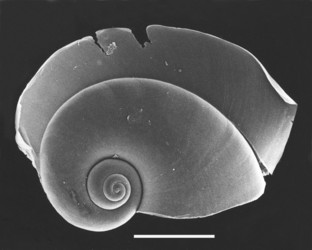
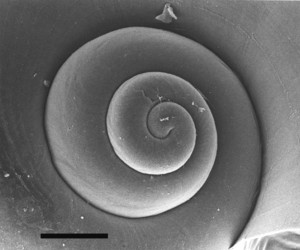
Figure. Scanning electron micrographs of the shell of Protatlanta souleyeti from the right side at low (left) and high (right) magnifications. Scale bars = 0.1 and 0.5 mm, respectively. © Roger R. Seapy
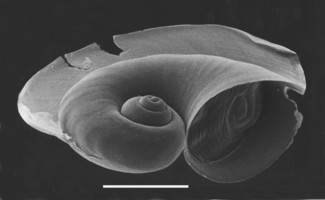
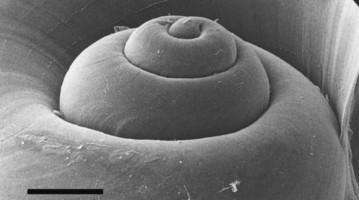
Figure. Scanning electron micrographs of the shell of Protatlanta souleyeti at about a 60° tilt, at low (left) and high (right) magnifications. Scale bars = 0.1 and 0.5 mm, respectively. ©
- Spire slightly elevated and rounded, with incised sutures, consisting of three whorls
- Surface of spire whorls smooth, except for a variant with which it co-occurs in the Atlantic Ocean (Richter and Seapy, 1999). In the latter form a low, spiral ridge is located in the middle of the whorl beginning on the second whorl and ending after about three-fourths of a turn on the third whorl. A less conspicuous and shorter spiral ridge is located inside the primary ridge on the second whorl
- Shell aperture large, ovoid in shape
- Umbilicus large (Tesch, 1949)
- Adult shell small (<2 mm); shell calcareous with a glass-like, cartilaginous keel composed of conchiolin
- Shell spire brownish- to reddish-orange (for example of latter color, see title illustration)
- Eyes type a, with distal pigmented tissue lacking a transverse slit (after Richter, 1961). Eye shape cuboidal in dorsal view
- Operculum type a, with a large gyre in the apical part of the operculum (termed macro-oligoyre; after Richter, 1961)
- Radula type I, large and triangular in shape. Central rachidian tooth monocuspid with a large, low basal plate. Lateral teeth monocuspid with a low process on the inner side. Marginal teeth monocuspid (Richter, 1961; Richter and Seapy, 1999)
- Larval shell with a smooth surface and a large ovoid aperture
Comments
Protatlanta souleyeti was reported by Richter (1974) as rare (only 4 specimens collected) during the Meteor Expedition in the northwestern Indian Ocean. In waters off Hawaii in the North Pacific Ocean, however, it was moderately abundant in three studies (Seapy, 1990a,b and 2008). In the first paper, which combined species counts from five plankton cruises, it ranked sixth of thirteen species, representing 7.8% of the total. In the second paper, a diel vertical distribution study, it ranked third of eleven species, accounting for 13.0% of the total mean species densities. In this study the highest mean densities (from 5 to 8 individuals per 1,000 m3) were recorded from depth intervals between 45 and 140 m. In the last study diel vertical distributions were determined from three stations at 1, 5, and 15 nmi off the coast of Oahu; it ranked fourth of ten species (6.7% of total mean nighttime density) in the spring and fifth of 15 species (6.9% of the total mean nighttime density) in the fall. Densities were mostly less than about 12 individuals per 1000 m3, although 34 individuals per 1,000 m3 were recorded from 30-40 m at the 1 nmi station in the spring.In the first of the diel vertical distribution studies off Hawaii (Seapy, 1990b), P. souleyeti was recorded to a depth of 140-200 m during the day and to 90-140 m at night. An upward nocturnal migration was evidenced from the surface to 45 m by a difference in the mean densities during the day (0.1 individuals per 1,000 m3) and at night (3.4 individuals per 1,000 m3). In the 2008 paper characterized above, the maximal daytime depth was 160-200 m at the 5 nmi station in the spring and 120-160 m at the 15 nmi station in both the fall and spring. Upward nocturnal vertical migration was only suggested at the 1 and 15 nmi stations in the spring. At the former station the species ranged to 80 m during the day, but mostly to only 40 m at night. Also, densities were higher in the 10 m depth intervals between the surface and 30 m at night. At the 15 nmi station it was recorded between the surface and 40 m at night, but was absent from these depths during the day.
References
Richter, G. 1961. Die Radula der Atlantiden (Heteropoda, Prosobranchia) und ihre Bedeutung für die Systematik und Evolution der Familie. Zeitschrift für Morphologie und Ökologie der Tiere 50: 163-238.
Richter, G. 1968. Heteropoden und Heteropodenlarven im Oberflächenplankton des Golfs von Neapel. Pubblicazioni della Stazione Zoologica di Napoli 36: 346-400.
Richter, G. 1974. Die Heteropoden der "Meteor" Expedition in den Indischen Ozean 1964/65. "Meteor" Forschungs-Ergibnisse Ser. D, No. 17, pp. 55-78.
Richter, G. and R. R. Seapy. 1999. Heteropoda, pp. 621-647. In: D. Boltovskoy (ed.), South Atlantic Zooplankton. Backhuys Publishers, Leiden.
Seapy, R. R. 1990a. The pelagic family Atlantidae (Gastropoda: Heteropoda) from Hawaiian waters: a faunistic survey. Malacologia 32: 107-130.
Seapy, R. R. 1990b. Patterns of vertical distribution in epipelagic heteropod molluscs off Hawaii. Marine Ecology Progress Series 60: 235-246.
Seapy, R. R. 2008. Offshore-onshore and vertical distributional patterns of heteropod mollusks off leeward Oahu, Hawaii. Marine Biology 154: 985-995.
Tesch, J. J. 1949. Heteropoda. Dana Report 34, 53 pp., 5 plates.
Title Illustrations

| Scientific Name | Protatlanta souleyeti |
|---|---|
| Location | Hawaiian waters |
| Specimen Condition | Live Specimen |
| Life Cycle Stage | adult |
| View | right side |
| Image Use |
 This media file is licensed under the Creative Commons Attribution-NonCommercial License - Version 3.0. This media file is licensed under the Creative Commons Attribution-NonCommercial License - Version 3.0.
|
| Copyright |
©

|
About This Page

California State University, Fullerton, California, USA
Correspondence regarding this page should be directed to Roger R. Seapy at
Page copyright © 2011
 Page: Tree of Life
Protatlanta souleyeti .
Authored by
Roger R. Seapy.
The TEXT of this page is licensed under the
Creative Commons Attribution License - Version 3.0. Note that images and other media
featured on this page are each governed by their own license, and they may or may not be available
for reuse. Click on an image or a media link to access the media data window, which provides the
relevant licensing information. For the general terms and conditions of ToL material reuse and
redistribution, please see the Tree of Life Copyright
Policies.
Page: Tree of Life
Protatlanta souleyeti .
Authored by
Roger R. Seapy.
The TEXT of this page is licensed under the
Creative Commons Attribution License - Version 3.0. Note that images and other media
featured on this page are each governed by their own license, and they may or may not be available
for reuse. Click on an image or a media link to access the media data window, which provides the
relevant licensing information. For the general terms and conditions of ToL material reuse and
redistribution, please see the Tree of Life Copyright
Policies.
- First online 29 October 2008
- Content changed 23 July 2011
Citing this page:
Seapy, Roger R. 2011. Protatlanta souleyeti . Version 23 July 2011 (under construction). http://tolweb.org/Protatlanta_souleyeti/28754/2011.07.23 in The Tree of Life Web Project, http://tolweb.org/





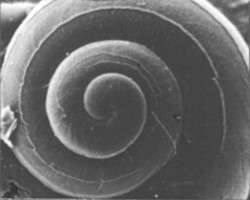
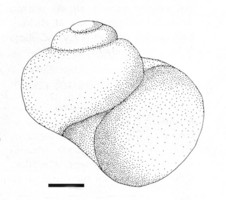
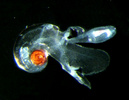


 Go to quick links
Go to quick search
Go to navigation for this section of the ToL site
Go to detailed links for the ToL site
Go to quick links
Go to quick search
Go to navigation for this section of the ToL site
Go to detailed links for the ToL site